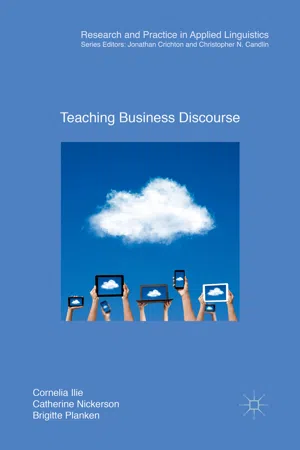This chapter will:
Define business discourse teaching as it will be referred to in the rest of this book;
Discuss the most important approaches that have been taken in business discourse teaching;
Give a geographical overview of how business discourse teaching has evolved around the world;
Provide a case study that illustrates one approach to business discourse teaching, alongside a set of tasks related to the business discourse classroom and a set of further readings.
This chapter will define the concept of business discourse and show how it underpins our understanding of business discourse teaching. It will introduce the most important approaches that have been taken to understanding business discourse and how to teach it, and it will introduce a number of important people located in different parts of the world who have helped shape the development of the field/discipline. The chapter will conclude with a set of further readings, a case study that provides an example of how to teach business discourse, and a set of tasks for readers to complete to help them understand more about business discourse teaching and how to integrate it into the classroom.
1.1 What Is Business Discourse Teaching?
In 2013, we wrote, “Business discourse is all about how people communicate using talk or writing in commercial organizations in order to get their work done” (Bargiela-Chiappini et al. 2013: 3). We saw business discourse as social action that takes place in different contexts as a means of completing a set of work-based tasks. We will be using this as the premise of this volume, where our concern will be how best to prepare different types of learners to communicate effectively in business in order to complete those tasks to achieve their work objectives. Business discourse teaching, therefore, is all about helping learners to communicate effectively in talk or writing to get their work done. In part one of this volume, we will be exploring how different findings in business discourse research have been incorporated into the classroom, including the different research methodologies that have been of influence, and we will also identify a number of possible ways in which the field may develop in the future.
In addition, as we have discussed elsewhere (e.g. Bargiela-Chiappini et al. 2013; Nickerson and Planken 2016), many people who are active as business discourse researchers are also involved with teaching, and their research findings have been influential on the approaches that they then take in the classroom. Some have also published in the area of business discourse teaching or they have created textbooks that combine both their research findings and their experience with business learners. In part two of this volume, we will showcase some of the projects that have combined business discourse research and business discourse teaching, and we will also look at several sets of teaching materials that are based on research findings.
Finally, in part three of this volume, we will present an overview of different types of learners and what works for them in terms of teaching, and we will also hear directly from a number of prominent researcher practitioners located in different parts of the world whose work has shaped and will continue to shape the field in the future. They include Ulla Connor and Diane Belcher for North America, Stephen Bremner, Michael Handford, Jane Lockwood, and Zuocheng Zhang for Asia, and Pamela Rogerson-Revell, Julio Gimenez, Stephanie Schnurr, Evan Frendo, and Almut Koester for Europe. Our concluding chapters will present a set of additional case studies that aim to illustrate the ideas we have put forward in our discussion and provide readers with a list of other resources including notable books and journals, professional associations, and conferences that are likely to incorporate research work on the teaching of business discourse, as well as other ideas for further study outside of this volume.
1.2 The Development of Business Discourse Teaching
Business discourse teaching has evolved from several parallel developments in business discourse research. Many researchers have taken what they found in their own study of business discourse and applied it in the classroom, and then, in turn, their experience in the classroom has found its way back into their research. In the examples below, from the context of Hong Kong, we first showcase Chan’s (2017) study of spoken business discourse and the way she integrated her findings into the classroom for use with Cantonese speakers of English. This is followed with an account of Evans’s (2012) approach to business email in the classroom, and the reasons why he selected certain features of that email for practice and discussion with his students. Both studies start by analysing a particular aspect of business discourse as it occurs in real life, and then show how this can be used to pedagogical effect with learners. We present them here as an introduction to business discourse teaching and its relationship with business discourse research. We will look in more detail at these specific studies and additional work by both Chan and Evans in part two of this volume, when we focus on classroom-based projects.
